
-
About PilatesOpen or Close
Pilates is an exercise system developed by Joseph Pilates in early 20th century. Pilates called his method "contrology" since it is principally a series of controlled movements using the mind to control the body. The heart of pilates exercise is core strength; core muscles are the deeper muscle layers of the torso which consists of the abdomen and back. Core muscles work together to stabilize and the spine during body movement.
Pilates have mainly six principles as follows:
Concentration:Concentration is necessary in any exercise for maximum benefits. Give full attention and commitment to each movement.
Centering:Bring the focus to the center of the body or the "core." By learning proper positioning of core muscles, one gains both abdominal strength and control, which supports and provides fluidity for all movements.
Breath:Correct and deep full breaths are essential. Deep inhalations energize and replenish your mind and body, while full exhalations help rid the body of toxins.
Control:Control involves the previous three principles. It allows movement of the body to occur without injury and promotes effective exercise movements. Each exercise should be done with complete muscular control.
Precision:Like concentration, precision requires focus. Any movement lacking precision can be harmful.
Flow:The Pilates method is not based on "static, isolated movements". Whether doing daily activities or Pilates exercise, our bodies should move in a synchronized and flowing manner. Jerky movements increase the risk of injury and reduce potential toning effects.
Originally designed as mat exercises, Pilates also incorporates various apparatus to help users train their bodies more easily. Each apparatus has its own series of exercises and uses springs to provide additional resistance. Hence, most exercises done on the equipment are "resistance training." The use of springs results in "progressive resistance" as the resistance increases as the spring is stretched.
Though the most commonly used equipment is the Reformer, other equipment includes the Cadillac (or Trapeze Table), the Combo Chair (or Wunda Chair/Stability Chair), the Ladder Barrel, the Spine Corrector (or Step Barrel) and the Arc Barrel (or Baby Arc). Many accessories are also available to enhance the exercise such as the Pilates Ring (or Magic Circle), the Flex Band (or Latex Band), the Pilates Ball (or Stability Ball), etc.
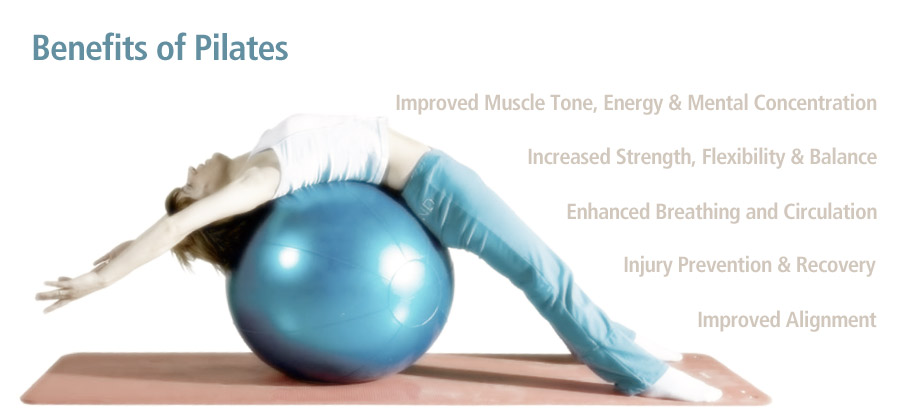
Unlike weight bearing exercises, Pilates utilizes resistance from springs, hence, elongates and strengthens muscles as well as improving muscle elasticity and joint mobility. A body with balanced strength and flexibility is less likely to get injured.
Since each movement in Pilates is done with focus and precision, mental concentration is naturally developed while breathing deeply and fully during the exercise helps enhance blood circulations.
-
ReformerOpen or Close
What is a Reformer?
The Reformer is a bed-like frame with a flat platform ("the carriage") on it. The carriage slides back and forth on a rail within the frame. It's attached to a set of springs on one end and a pair of ropes on the other. The springs provide differing levels of resistance as the carriage is pushed or pulled along the frame. Shoulder blocks ("shoulder rests") prevent users from sliding off the end of the Reformer during the exercise.
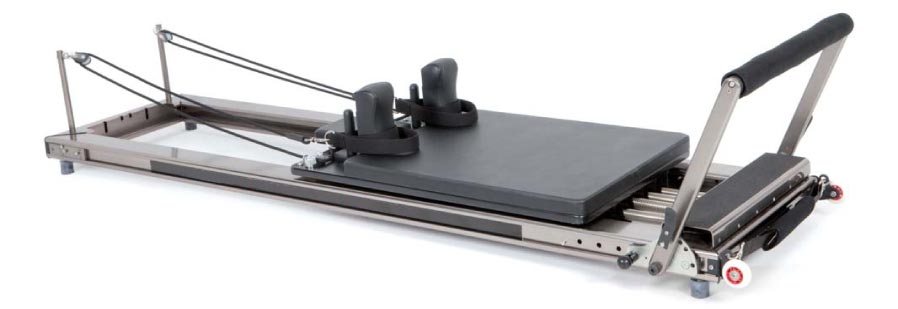
Carriage can be slided in two ways, either by pressing hands or feet against foot bar at the end of the Reformer (springs side), or by pulling the straps (connected with the ropes at the other end of the carriage) with hands or feet. Either way the springs will be pulled and pushed, providing resistance to the exercise.
How to use a Reformer
With the Reformer's versatility, exercises can be done in numerous positions such as lying down, sitting, pulling the straps, pushing the foot bar, perched on the foot bar or shoulder rests, and more. The exercises mostly involve pushing or pulling the carriage, or holding the carriage still with springs providing resistance.
Benefits of a Reformer
The Reformer not only provides all the Pilates benefits such as strength, flexibility, coordination, and balance, but also improves daily life with better posture and body movement as well as relief in pain caused by physical imbalances including back pain.
Full range of motions can be done on the Reformer, increasing flexibility while developing strength. The Reformer also promotes "eccentric muscle contractions," occurring when a muscle lengthens while resisting a force, which are keys to achieving long lean muscles Pilates is known for. Usually, muscles contract eccentrically when practitioners control the return of the springs to their starting position. During a biceps exercise, biceps muscles contract concentrically as users flex elbows to pull the hands towards shoulders, and contract eccentrically as users extend elbows to return to starting position with control.
By controlling movement of the carriage attached to the springs set at different levels of resistance, practitioners build up their strength and balance. High resistance from springs (heavy setting of springs) doesn't always build more strength; some exercises are more challenging with lighter springs as they require more strength to control and stabilize the movement.
Last but not least, a Reformer is suitable for anyone with any level of fitness. For people who need exercise that is gentle on the joints, the Reformer offers a non-impact form of exercise that strengthens the core and tones all the muscles in the body.
-
CadillacOpen or Close
What is a Cadillac?
Allegedly designed in the early days for bed-confined patients to exercise, the Cadillac is a specialized Pilates equipment with which users can tone almost every muscle group in their bodies. The Cadillac is a fully functional trapeze table, that's why Pilates enthusiasts call it a "Cadillac" after a luxury car that offer numerous appealing features.
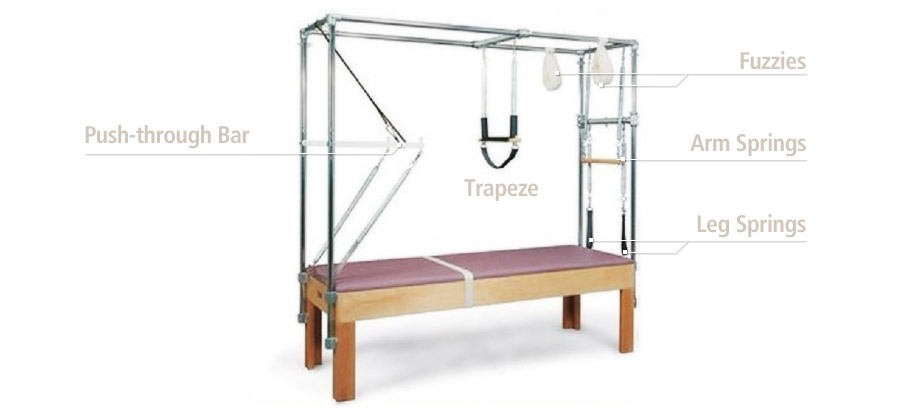
A Cadillac is mainly composed of the following:
- A table (or bed) as a base supporting users during exercise.
- A metal frame above the table to where a trapeze is attached. Users can hang from the trapeze or hang onto to the top bars where their bodies maybe hanging upside down or laterally.
- Spring loaded attachments such as push-through bar, arm springs, and leg springs, which can be strapped to arms or legs to challenge muscle groups in the limbs from a position on the table.
- Fuzzy loops which users can hang onto for more gravity based exercise, working the wrists, ankles, and upper and lower body muscles.
Benefits of the Cadillac
The Cadillac combines the benefits of a mat workout with added spring tension. The stretching and pulling of muscles and bones with spring loaded bars and straps stretch the body from head to toe. In a way it is more challenging than a mat exercise.
Moreover, the Cadillac is well known for its versatility as over eighty types of exercises can be performed, ranging from low intensity movements to highly trained routines, involving hanging from the bar. One can strengthen core muscles, develop a more flexible spine, and stretch the body effectively with the Cadillac.
-
Half-TrapezeOpen or Close
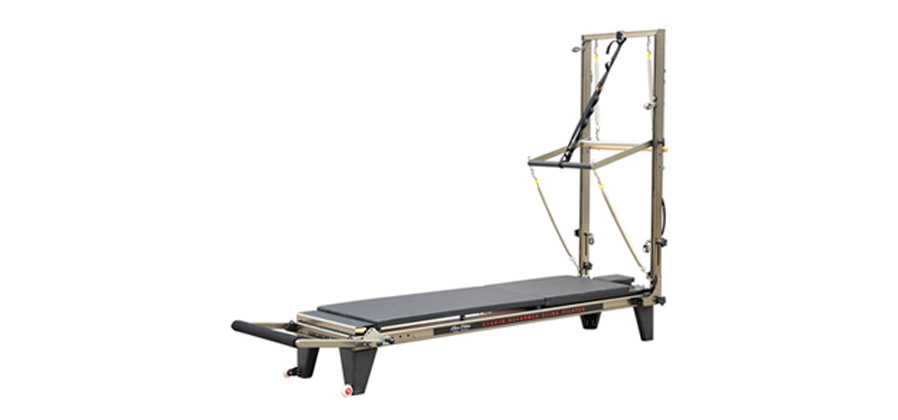
The Pilates Half-Trapeze is probably the most versatile Pilates equipment as it has features of both the Reformer and Cadillac combined. The base of the Half-Trapeze has the same features as the Reformer with a wall unit attached at the other end. There's also a bed extension, which can be connected to the Reformer carriage to make a one long bed. The wall unit comprises a trapeze bar, push-through bar, arm springs, and leg springs just like the Cadillac. Exercising with the Half-Trapeze, users gain benefits that both the Reformer and Cadillac have to offer.
-
Combo ChairOpen or Close
What is a Combo Chair?
As the name suggested, the Combo Chair is a chair with padded top and pedals. The pedals are hinged to the lower end of the chair; springs are attached to the pedals to provide resistance when being pressed. The pedals can be used as one or split into two parts moving separately for a more challenge workout.
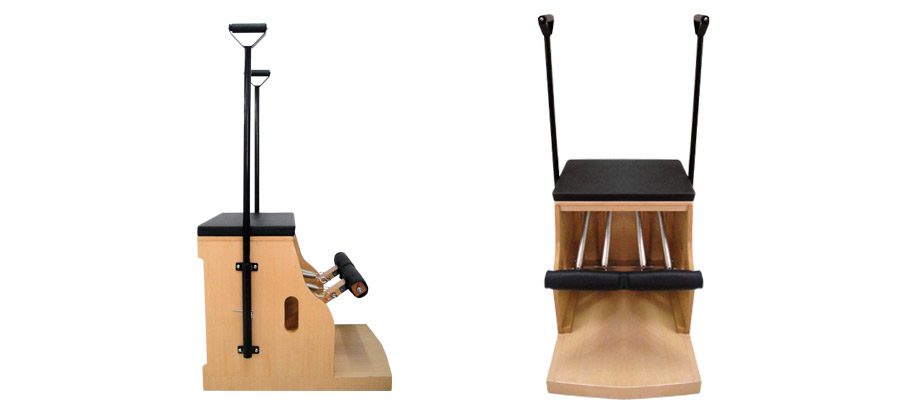
Despite the basic design, numerous exercises can be performed with the Chair. Exercises can be done lying, sitting and standing on the Chair or on the sides of the Chair. Users develop stability and flexibility through the exercise repertoire.
Benefits of the Combo Chair
Aside from enhanced body coordination, one can expect increased strength in core muscles, activation of buttocks and pelvic muscles as well as toned legs, arms and buttocks. The chair is easy to adjust, users can maintain the workout flow and keep the heart rate up for calories burning throughout the exercise.
-
BarrelOpen or Close
Pilates Barrel is a barrel-shaped exercise equipment, available in 3 forms and sizes – the Ladder Barrel, the Spine Corrector (Step Barrel), and the Arc Barrel (Baby Arc). However, they all have common features such as barrel-like surface, which is designed to isolate deep postural muscles and challenges the body across several movement planes.
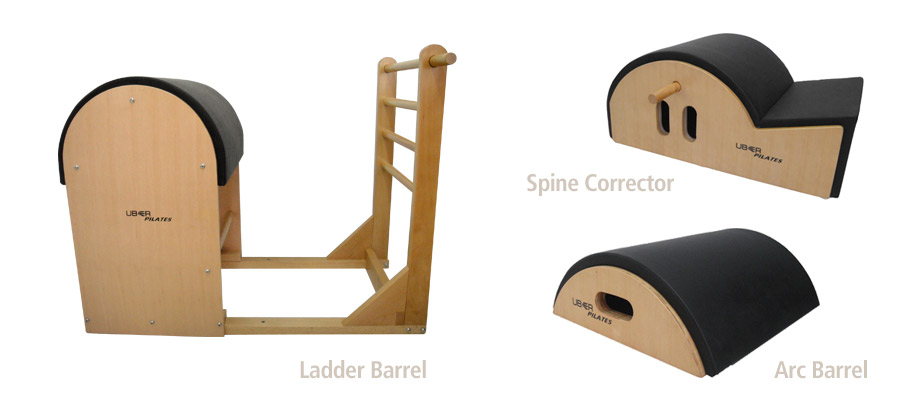
The Ladder Barrel
The Ladder Barrel consists of ladder-like rungs and rounded barrel-like surface. The rungs are connected to the barrel by 2 bottom rails (base), which are adjustable to accommodate varying body shapes and sizes.
Stretching, strengthening and flexibility exercises are performed on the barrel surface. Users can put their feet through the rungs for stability while leaning back across the curved barrel to stretch their backs and extend the spines.
The Spine Corrector (Step Barrel)
The Spine Corrector is a half-circle arc angled with a step and generally has grapping handles on the sides for extra stability.
It is designed to work abdominal, shoulder, and back muscles. It helps reinforce the shape of the spine and works the postural muscles. With appropriate use, the Spine Corrector can help correct spinal deformities, such as humpback, caused by aging or other disorders such as osteoporosis, scoliosis and arthritis. Some exercises on the Spine Corrector also work the chest muscles, opening up the chest, which facilitates fuller and deeper breathing.
The Arc Barrel (Baby Arc)
The smallest of all three is the Arc Barrel; it is arc-shaped and light, easy for storage, and sits directly on the floor. The arc surface is used to support shoulders, back, or abdominals (depending on the exercise), and to open up the neck, hips and thighs.
It is complementary to Pilates mat workouts and useful in providing tension relief and injury. For example, in "hundred" exercise, users can support the shoulders with Arc Barrel. Doing so will assist abdominals with thoracic flexion. Resting head on Barrel as well will eliminate neck tension while encouraging thoracic flexion.

All exercises should be done under the guidance of a certified Pilates instructor. And if you have any medical conditions, consult your doctor before performing any physical exercise.
Sources: